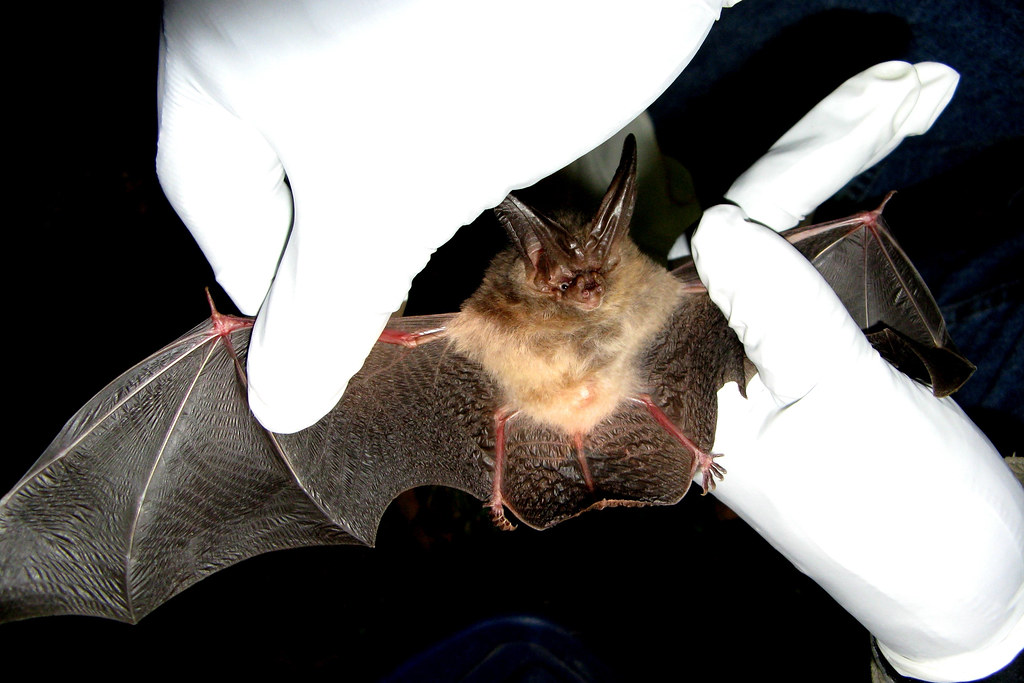
 自然保护与休闲部
自然保护与休闲部保护·守护·共享
 自然保护与休闲部
自然保护与休闲部朱莉·布坎南发布于 10 月26日, 2020

三色蝙蝠。照片由 Phil Lucas 拍摄。
十月的最后一周是蝙蝠周,这是一个认识蝙蝠为全球生态系统做出的重要贡献的时刻。
这些有翅膀的哺乳动物几乎生活在地球上的各个地方,虽然你可能永远看不到它们,但它们很有可能生活在你附近。
尽管蝙蝠周恰逢万圣节,但人们并不需要害怕蝙蝠。世界各地的1 、 400种蝙蝠提供从昆虫控制到授粉等多种服务。它们是自然生态系统中不可或缺且有益的组成部分。
弗吉尼亚州是16种蝙蝠的家园,其中包括新来的巴西无尾蝙蝠 ( Tadarida brasiliensis ),它是因气候变暖而于近期抵达的。弗吉尼亚州甚至有自己的州蝙蝠:弗吉尼亚大耳蝠( Corynorhinus townsendii virginianus ),这是一种联邦濒危物种。
 弗吉尼亚大耳蝙蝠。照片由弗吉尼亚州自然保护和娱乐部 JH Fagan 拍摄。
弗吉尼亚大耳蝙蝠。照片由弗吉尼亚州自然保护和娱乐部 JH Fagan 拍摄。
Nearly a quarter of bats are considered critically endangered, endangered or vulnerable, according to Bat Conservation International. The disease white-nose syndrome appeared in New York in 2006 and through 2012 had killed nearly 7 million bats in the Eastern United States and Canada, including tens of thousands in Virginia. Habitat loss and climate change are other major threats.
Bats are particularly vulnerable to threats posed by disease and habitat loss. Unlike most mammals their size, individual bats can live up to several decades with most species only producing a single offspring per year.
“Even without additional threats, it will take decades for populations to recover from the white-nose syndrome epidemic,” said Wil Orndorff, karst protection coordinator with the Virginia Department of Conservation and Recreation. “Now more than ever, people need to value and respect bats.”
Recent events have served to reinforce bats’ bad reputation. SARS Coronavirus 2, the virus causing COVID-19, is believed to have originated in China from a species of horseshoe bat, distant relatives to North American bat species. Bats are known to carry rabies, and bat species in other parts of the world have been linked to other zoonotic diseases.
However, if bats are treated with respect and left alone, the health risk they pose to humans is small when compared to the huge benefit they provide in controlling insect pests.
DCR is involved in many bat protection efforts with partners such as the Virginia Department of Wildlife Resources, faculty and students from Radford University and Virginia Tech, landowners, and volunteers from the conservation and caving communities. Scientists with DCR’s Natural Heritage Program monitor known bat populations and search for undocumented roosts and hibernacula to assist in conservation efforts to benefit bats.*
DCR’s work also involves a range of activities to protect bat habitat, including the acquisition and management of natural areas used by bats, the installation of gates at cave entrances to limit human access impacts, and education to cave owners and the caving community.
“While bats, being nocturnal, are out of sight to most of us, they should not be out of mind,” said Jason Bulluck, director of the Virginia Natural Heritage Program. “They are a valuable part of Virginia’s native biodiversity and critical to balancing insect populations. Most importantly, bats help to control large population outbreaks of non-native insects, which pose enormous threats to agricultural crops.
“保护蝙蝠及其栖息地的努力有助于确保它们能够持续提供免费的生态系统服务,从而维护生物多样性并造福人类。”
关于蝙蝠的更多信息
弗吉尼亚州自然遗产喀斯特计划
弗吉尼亚州野生动物资源部
美国鱼类和野生动物管理局 – 弗吉尼亚州大耳蝙蝠情况说明书
白鼻综合症应对小组 – 森林管理和蝙蝠
*由于担心在新型冠状病毒大流行期间人类处理蝙蝠的方式,DCR 和 DWR 已暂停涉及与蝙蝠直接接触的工作。
DCR 喀斯特保护协调员 Wil Orndorff 和自然遗产项目主任 Jason Bulluck 对本文亦有贡献。
分类
自然遗产

